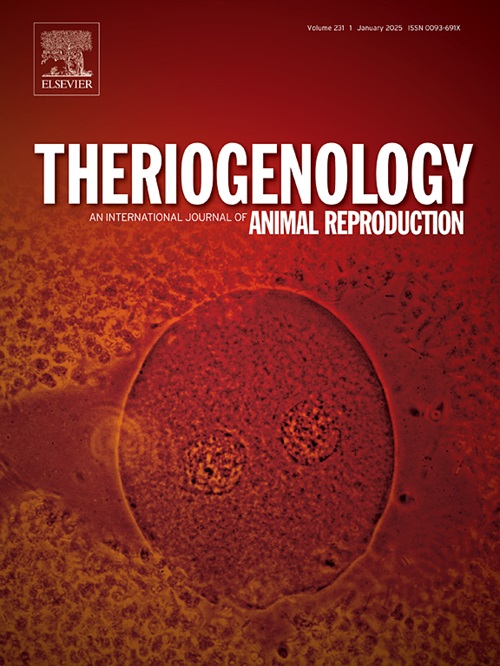NAGK regulates the onset of puberty in female mice
IF 2.5
2区 农林科学
Q3 REPRODUCTIVE BIOLOGY
引用次数: 0
Abstract
This study examines the role of N-acetylglucosamine kinase (NAGK) in initiating puberty in female mice. We employed real-time quantitative reverse transcription polymerase chain reaction (RT-qPCR) and immunofluorescence to measure NAGK expression in the hypothalamic-pituitary-ovarian axis across various developmental stages: infant, prepuberty, puberty, and adult. We further investigated the impact of Nagk gene knockdown on puberty in female mice. This included assessing the expression of puberty-related genes both in vivo and in vitro, GT1-7 cells proliferation and apoptosis, concentrations of GnRH and Kisspeptin, puberty onset timing, serum levels of progesterone (P4) and estradiol (E2), and ovarian morphology. Results revealed that Nagk mRNA is present in the hypothalamus, pituitary, and ovaries throughout different developmental stages in female mice. In the hypothalamus, Nagk mRNA levels were comparable during infant and prepuberty, lowest during puberty, and highest in adult. In the pituitary, Nagk mRNA peaked in adult, with no significant variation between infant, prepuberty, and puberty. In the ovaries, Nagk mRNA levels increased during puberty and peaked in adult. NAGK is predominantly located in the arcuate nucleus (ARC), periventricular nucleus (PeN), dorsomedial hypothalamic nucleus (DMH), paraventricular nucleus (PVN), adenohypophysis, and in the ovarian oocytes, interstitium, and granulosa cells across all developmental stages in female mice. Nagk knockdown in GT1-7 cells decreased the transcriptional level of Gnrh, Kiss1, Gpr54, Igf1 and Mapk14 mRNA and cell proliferation but increased the level of β-catenin mRNA and cell apoptosis, while reducing GnRH secretion. Following ICV injection, Nagk gene knockdown mice exhibited delayed the timing of vaginal opening (VO) and reduced hypothalamic levels of Gnrh, Kiss1, Gpr54, Igf1, Mapk14, and β-catenin mRNA. Additionally, serum concentrations of E2 in Nagk gene knockdown mice were significantly lower compared to the control group. These findings indicate that Nagk regulates the expression of Gnrh and Kiss1 mRNA in GT1-7 cells, affects hypothalamus Gnrh mRNA levels and serum E2 concentration, and that its knockdown can delay puberty onset in female mice.
NAGK 调节雌性小鼠青春期的开始。
本研究探讨了N-乙酰葡糖胺激酶(NAGK)在雌性小鼠青春期启动过程中的作用。我们采用实时定量反转录聚合酶链反应(RT-qPCR)和免疫荧光技术测量了NAGK在下丘脑-垂体-卵巢轴各发育阶段(婴儿期、青春前期、青春期和成年期)的表达。我们进一步研究了Nagk基因敲除对雌性小鼠青春期的影响。这包括评估体内和体外青春期相关基因的表达、GT1-7细胞的增殖和凋亡、GnRH和Kisspeptin的浓度、青春期开始时间、血清中孕酮(P4)和雌二醇(E2)的水平以及卵巢形态。结果发现,Nagk mRNA存在于雌性小鼠下丘脑、垂体和卵巢的不同发育阶段。在下丘脑中,Nagk mRNA水平在婴儿期和青春前期相当,在青春期最低,在成年期最高。在垂体中,Nagk mRNA在成年期达到峰值,在婴儿期、青春前期和青春期之间没有显著差异。在卵巢中,Nagk mRNA水平在青春期增加,在成年期达到峰值。在雌性小鼠的所有发育阶段,NAGK主要位于弓状核(ARC)、室周核(PeN)、下丘脑背内侧核(DMH)、室旁核(PVN)、腺嗜酸核以及卵巢卵母细胞、间质和颗粒细胞中。在GT1-7细胞中敲除Nagk会降低Gnrh、Kiss1、Gpr54、Igf1和Mapk14 mRNA的转录水平和细胞增殖,但会增加β-catenin mRNA的水平和细胞凋亡,同时减少GnRH的分泌。经 ICV 注射后,Nagk 基因敲除的小鼠表现出阴道开放(VO)时间延迟,下丘脑中 Gnrh、Kiss1、Gpr54、Igf1、Mapk14 和 β-catenin mRNA 水平降低。此外,与对照组相比,Nagk基因敲除小鼠血清中的E2浓度明显降低。这些研究结果表明,Nagk能调节GT1-7细胞中Gnrh和Kiss1 mRNA的表达,影响下丘脑Gnrh mRNA水平和血清E2浓度,敲除Nagk基因能推迟雌性小鼠青春期的到来。
本文章由计算机程序翻译,如有差异,请以英文原文为准。
求助全文
约1分钟内获得全文
求助全文
来源期刊

Theriogenology
农林科学-生殖生物学
CiteScore
5.50
自引率
14.30%
发文量
387
审稿时长
72 days
期刊介绍:
Theriogenology provides an international forum for researchers, clinicians, and industry professionals in animal reproductive biology. This acclaimed journal publishes articles on a wide range of topics in reproductive and developmental biology, of domestic mammal, avian, and aquatic species as well as wild species which are the object of veterinary care in research or conservation programs.
 求助内容:
求助内容: 应助结果提醒方式:
应助结果提醒方式:


